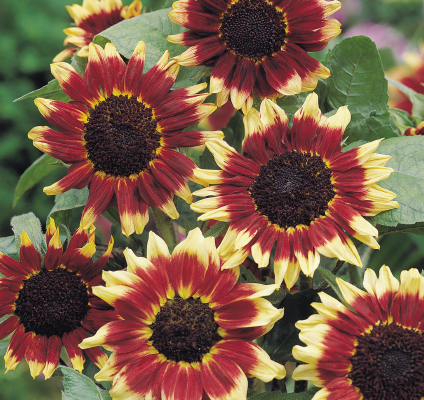
Florenza
Item no.: HA0801R- Lateral branching
- Extraordinary, eye-catching color
- Light yellow petal tips contrast with a rusty red ring
- Flower size up to 5“ (12 cm)
- Crop Time
- Spring: 10 - 12 weeks
- Height ∅
- 43 ″ / 110 cm
- Flower Size ∅
- 5 ″ / 12 cm
- Exposure
- Sun
- Seed Form
- Raw Seed
- Best Uses
- Bedding, Cutflower
Culture guide
Usage
Plants for bedding, cut flower production
Sow time
Indoor forcing: March-August, sowing in intervals; Outdoor forcing: April-Mid July
Sowing method
1-2 seeds per plug, sowing directly into field is recommended
Germination
5 days at 65-75 °F (18-24 °C). Supplemental lighting during plug germination improves quality. Stage II 70 °F (21 °C). Increased light levels during plug production to control seedling stretch are beneficial to overall crop quality. Stage III & IV reduce temperatures to 62 °F (17 °C), begin feeding at 100-150 ppm.
Growing on
Direct sow seed or transplant at two true leaf stage. Space seed or seedlings at 5x5'' (12x12 cm). Begin fertilizing at 100 ppm nitrogen after transplanting. Increase fertilization to 200-250 nitrogen in a well-balanced mix after three weeks. Maintain temperatures above 68-72 °F (20-22 °C) for improved stem length and flower quality. Fertilize weekly at 200-250 ppm nitrogen. Do not allow plants to become dry as leaf scorch can occur. Late day watering can also contribute to foliage disorders.
Media
Field: Before sowing treat substrate with herbicide or fight the weeds mechanically and fertilize the field. The seeds should develop without any plant concurrence. Standard fertilization: 100-120 g/m² of a slow release fertilizer. Greenhouse: Use a well-drained, growing substrate with 15-30 % clay, 1-3 kg/m³ complete balanced fertilizer, 0-2 kg/m³ slow release fertilizer (3-6 months), iron-chelate, micronutrients, pH: 5.5-6.2.
Temperature
Field: cultivation is possible from April onwards. Grow at 15-18 °C. Cultivate flowering plants not below 12 °C. Helianthus plants do not tolerate frost.
Fertilization
Field: N min soil value: approximately 150 g/m². Avoid high nitrogen levels in soil. Temperatures below 10 °C can be a cause for iron and phosphate deficiency. Greenhouse: High fertilization levels are required. Fertilize the crop weekly with 200-250 ppm nitrogen, using a potassium balanced fertilizer (N: K₂O-ratio: 1:1,5). Avoid high ammonium and high nitrogen levels. Prevent magnesium deficiency by applying magnesium sulphate (0,05 %) 1-2 times and in case of iron deficiency apply iron-chelate for 1-2 times.
Stage I Starts with the radicle breaking through the testa. The roots are touching the medium. Ends with fully developed cotyledons.
Stage II Starts from fully developed cotyledons. Ends with the fully developed true leaf or true leaf pair.
Stage III Starts from the fully developed true leaf or true leaf pair and ends with 80% of the young plants being marketable.
Stage IV All young plants are ready for sale and in the process of being hardened off. This stage lasts about 7 days.
The cultural recommendations are based on results from trials conducted under Central European conditions. Different conditions in other parts of the world may lead to deviations in results achieved.